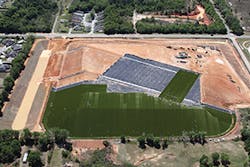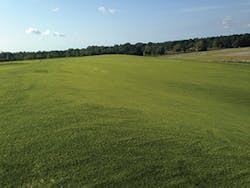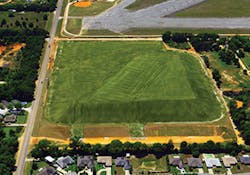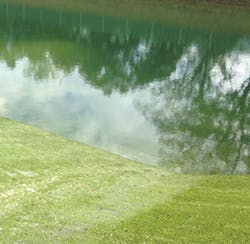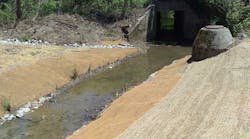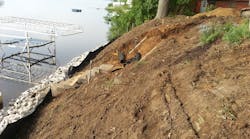This article first appeared in the July-August 2016 issue of Erosion Control.
Capping and closing a municipal solid waste (MSW) landfill can be a civil engineering challenge. The goal is to eliminate any need for further erosion control work on the site to ensure that the landfill keeps its structural integrity. True, landfill owners are required to adhere to EPA’s post-closure rules as defined by Subtitle D of the Resource Conservation and Recovery Act, which include maintenance of the leachate collection system, groundwater monitoring system, methane gas monitoring system—and, germane to erosion control activities, the final cover system. But having more structural work done after a landfill has been capped and closed can be costly and can damage the owner’s reputation.
This article includes an example of a project in which a landfill was capped to prevent outflow of leachate and sediment to groundwater sources.
Protecting Groundwater in Florida
One of the biggest concerns with closing and capping landfills is keeping stormwater runoff from commingling with leachate within the landfill and contaminating nearby groundwater. In some cases, previously capped landfills need remediation to ensure that this problem does not continue to occur.
The 25-acre Saufley Field construction and demolition (C&D) landfill in Pensacola, FL, is one such case. The site was abandoned by its previous owner in 2008. Prior to the abandonment of the facility, the Florida Department of Environmental Protection (FDEP) documented numerous compliance issues since the site was permitted in 1990. The most severe noncompliance issues included operation of the facility at elevations approximately 40 feet higher than the permitted design height and the presence of hydrogen sulfide emissions. In fact, the air pollution associated with the operations of the facility became so extreme in 2007 that the Florida Department of Health issued a report declaring a public health warning with regard to elevated levels of hydrogen sulfide around the facility that were affecting the local community.
Additionally, the stormwater management design of the facility allowed both sediment and leachate to be released offsite, discharging into neighboring stormwater systems maintained and operated by Escambia County. Last but not least, groundwater contamination was recorded with elevated levels of aluminum, arsenic, and manganese, which also resulted in significant fines and violations.
FDEP and Escambia County leadership quickly realized that while this site remained open, it posed a threat to the environment and the health of the citizens surrounding the facility. The only answer to the problem was to close the facility, which in itself posed several significant challenges. Funds were not available to construct a closure, and the closure plan would involve significant site improvements to address the noncompliance issues. After evaluating other traditional soil cover systems in 2012, both FDEP and Escambia County selected the ClosureTurf system based on several criteria.
In addition to the Hydrofill, the Saufley Field landfill cap has
an impermeable, highly transmissive structured geomembrane and an engineered synthetic turf layer.
The system was determined to be the most economical approach to performing a closure. The “soiless” technology reduced the need for natural resources, i.e., soil for constructing the system. It would offer superior protection against erosion along slopes and in downchutes and perimeter conveyance channels. The system promised to reduce infiltration of stormwater into the waste, minimizing impacts to groundwater quality. The remediated site would also have enhanced emission control. And the system would reduce sediment loadings of stormwater runoff to the surrounding watershed.
ClosureTurf is a patented three-component system consisting of Agru America Super Gripnet geomembrane, an engineered synthetic turf layer, and a specified infill, usually ASTM C-33 sand or Hydrobinder, a cementitiously bound infill for concentrated hydraulic flow areas. The impermeable, highly transmissive structured Super Gripnet geomembrane reportedly provides the highest interface friction values on the market. The engineered synthetic turf, consisting of UV-resistant, high-density polyethylene grass fibers, is designed to provide the natural look and feel of grass while protecting the geomembrane from extreme weather conditions and trafficking stresses over the long-term. The specified infill component is placed between the blades of the engineered synthetic turf and allows the system to sustain vehicle loading while also providing additional protection from weathering.
The 25-acre Saufley Field C&D landfill in was capped using a “soiless” system.
During construction, advantages included a reduced need for soil because the system uses a tufted geosynthetic erosion layer, i.e., engineered synthetic turf, and typically installs at least 40% faster than traditional vegetative cover systems. Over the long-term post-closure period and beyond, surface water rapidly drains off and is not restricted by the hydraulic conductivity of the cover drainage system, reducing cap infiltration and minimizing the impermeable layer hydraulic head and subsequent waste infiltration. The system is designed to be a virtually maintenance-free cover system, and its dust-inhibitive design eliminates the need for watering. Finally, the system is engineered with increased geotechnical factors of safety so it provides increased protection from sloughing and veneer failures.
The geosynthetic erosion layer concept used on the project yielded significant savings by eliminating the need for large amounts of soil that otherwise would be used to cover the geomembrane. The design also promises stability and resilience during severe weather events. The ClosureTurf maintained the landfill’s structural integrity during a historic flash flood event in April 2014. The system performed despite rainfall levels of 5.68 inches in a single hour and between 22 to 26 inches of rain over a 24-hour period. According to the National Oceanic and Atmospheric Administration (NOAA), it was the highest calendar day total dating to 1879. The NOAA HDSC Precipitation Frequency Map indicates that it was a 1-in-200-year to 1-in-500-year single hourly amount, and the 24-hour rainfall total was a 1-in-50- to 1-in-100-year event.
View of relatively clean stormwater runoff in a sediment pond at the Saufley Field landfill.
The system is also designed for functional longevity and significantly low long-term care costs. Most importantly, the system is expected to virtually eliminate any stormwater infiltration into the C&D landfill and resulting leachate outflows.
